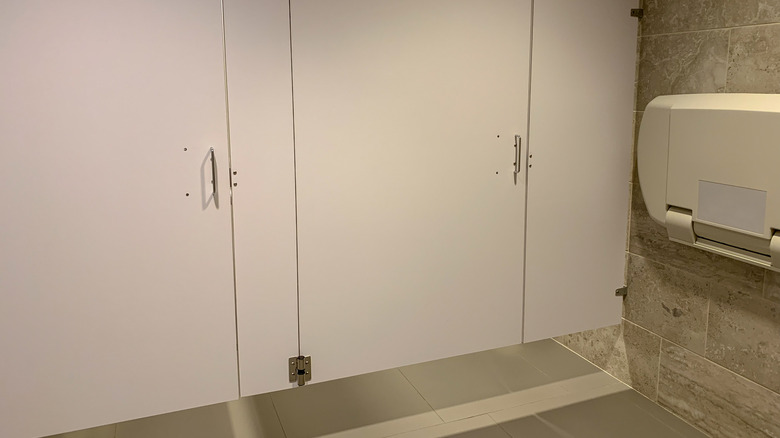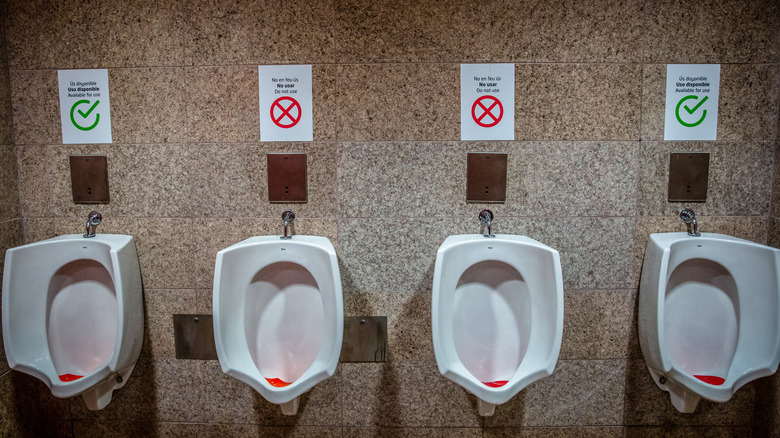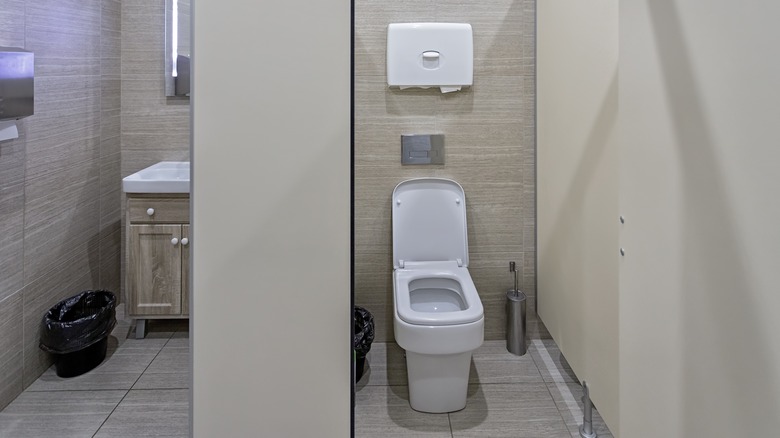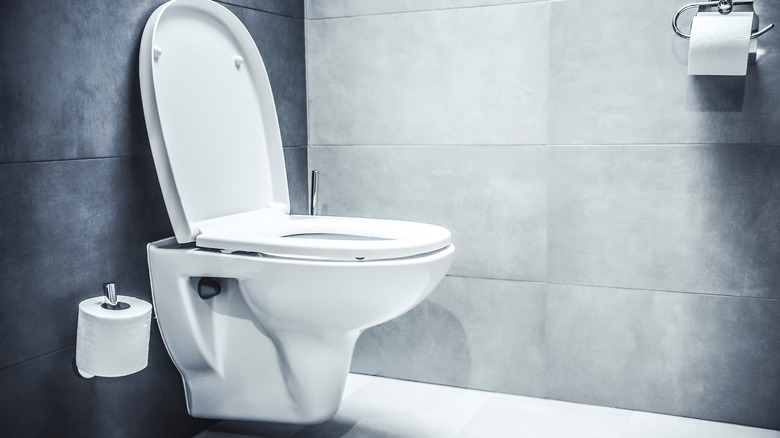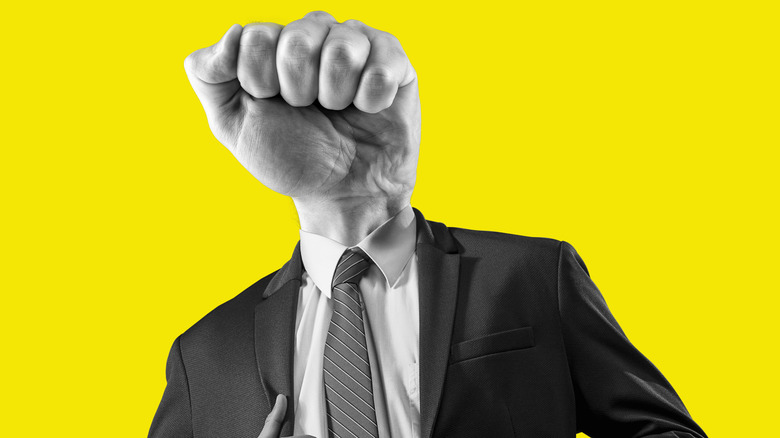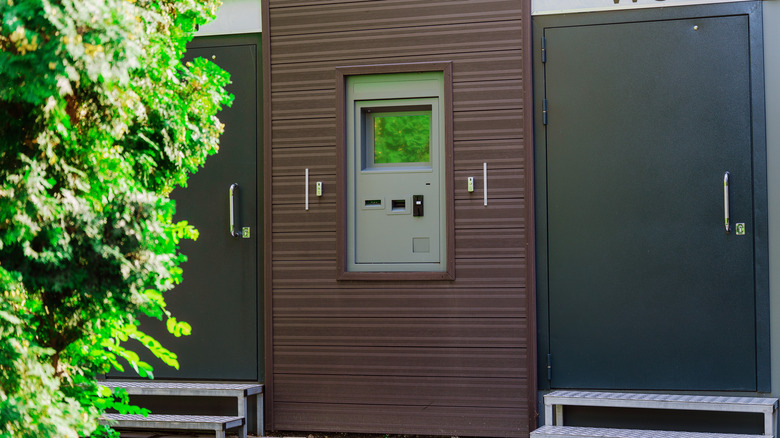The Unusual Origin Of Free Public Bathrooms In The US
No matter how valiantly you may try, there's no escaping the fact that human beings will have to use the restroom from time to time. There's a reason the space industry has spent billions on developing toilets to work up there: You simply cannot stop up the human digestive system safely, and when you gotta go, you gotta go.
Here on the ground, it's not much of a problem at all. Whether you're in an airport, a train station, or a private business, if nature calls, you can simply duck into a restroom, do your business, and be done with it. For free. In other parts of the world, however, things are different. Going to the bathroom in a public place often involves a fee, whether you drop a coin into a slot to gain access to the facilities or you drop a few coins in the restroom attendant's tray on your way out. While it's commonplace outside of the U.S., and no one bats an eye at it, pay toilets haven't been a thing in the States for five decades, according to the Associated Press.
Why make people pay to go to the bathroom?
Before getting into a discussion of why we (generally) don't charge people to use the restroom in the U.S., we should probably discuss the matter of why charging someone for the privilege exists in the first place.
The most obvious reason for charging users to use the toilet is because toilets and plumbing aren't free, and neither is their maintenance. As Mental Floss reports, passing the cost onto the consumer made some amount of sense, although the website notes that maintenance costs can easily exceed the revenue generated by the trifling coins required to use the toilets. Putting a kind of paywall on them also made sure that no one other than people with actual "business" would be in them, keeping out vandals, for example, or drug users who may want to get their fix in private.
Of course, that's how things should work ideally. In practice, the toilet-locking industry found out that Americans, unlike Europeans, get rather salty about having to pay to use the washroom, and the unpopular devices were eradicated thanks largely to four Ohio teenagers.
Rebels with a cause
Back in the late 1960s, Ohio teenager Michael Gessel and his family were on a road trip when they stopped at a Howard Johnson restaurant along the Pennsylvania Turnpike. It was there that the young lad and his brother encountered pay toilets and were downright indignant about the whole thing. (The Pennsylvania Turnpike at the time was "notorious" for its preponderance of pay toilets, notes Pacific Standard).
Why the Gessel lads were so upset about this is unclear. By this point, pay toilets were basically ubiquitous across America, having been around for decades. Their beginnings can be traced to the railroad industry around the turn of the century. Train stations were often the only places around that had modern plumbing, and the railroad companies were keen to keep locals from using the free toilets. Initially, employees would unlock the doors for paying customers, but eventually, the process was replaced with coin-operated mechanisms, almost exclusively produced by the Nik-O-Lok Company. By 1970, there were tens of thousands of them all across the U.S.
Nevertheless, the Gessel boys were outraged and decided to take action. However, they were concerned that their youth and inexperience would be hindrances. "We really didn't know how to exercise political power, but we thought we'd have fun with it. And we didn't like pay toilets," Michael said, per Pacific Standard.
CEPTIA is formed
The Gessel brothers (Michael and Ira) teamed up with two of their friends, Steve Froikin and Natalie Precker, and formed the Committee to End Pay Toilets in America, or CEPTIA (per the Associated Press).
If we were to put CEPTIA on a Venn diagram, it would be where the circles "Teenage Prank Writ Large" and "Genuine Political Advocacy" intersected. The four teens, though serious in their goals, carried out their campaign — letter-writing, public meetings, starting local chapters — with tongue planted firmly in cheek. For example, the group's logo was a fist, chains in its grasp, emerging from a toilet bowl. The group's unofficial anthem was the song, "Ballad of the Pay Toilet," presumably written by one of the teens.
The lads (and lass) had an ally in the feminist movement. These days, some women's and girls' advocates want to see jurisdictions eliminate sales taxes on menstrual products, equating them to an indirect tax on being female (via Global Citizen). Two generations ago, women regarded pay toilets as the same thing. That's because, putting aside public decency laws, men and boys can typically "go" wherever they stand. Not an option for women and girls, and as such, the Ohio teens had unlikely allies in the burgeoning feminist movement of the time.
The pay toilet industry fights back
Within a few years, CEPTIA had gained steam, with Americans from coast to coast expressing their frustrations with having to pay to do their business. The four teens were now college students, and their efforts were paying off. For example, by 1973, Chicago was working on legislation to ban pay toilets in the Windy City, according to the Associated Press. Soon other cities and states were following suit.
Of course, the pay-toilet industry company wasn't at all amused by the Ohio teens' "kind of a joke" that had become a nationwide thing. As the country's manufacturer of pay toilets (which also took a cut of the money deposited into them), they were in danger of losing business, if not going out of business entirely. The stakes were high, too; according to Pacific Standard, the company and another pay-toilet manufacturer, American Coil Lock Company, responded by appealing to prejudice and hysteria. "[Pay toilets] discourage drug addicts ... muggers and just plain hippies from haunting public restrooms," the industry said.
Despite the complicated and contentious period in American history that was the 1970s, it seems that the need to get rid of pay toilets was the one thing Americans could agree on, and by 1980, pay toilets were all but extinct in the U.S.
Pay toilets are making a comeback, sort of
Before proceeding with our discussion of the new version of pay toilets that's becoming a thing in the U.S., it bears noting that, inexplicably, the Nik-O-Lok corporation is still a thing. Their website looks like it hasn't been updated since the Clinton administration, but nevertheless, there it is.
Meanwhile, pay toilets are creeping back into the American landscape, but they should be viewed not through the lens of "making a buck on Americans' need to pee" but through the lens of "a noble experiment in urban engineering." For example, New York City, as recently as 2018, had a few pay toilets — standalone structures along busy pedestrian routes. They even had a loyalty program of a sort: Pay $8, and you have unlimited access to them for the day, as The Travel reports. San Francisco has or had a few similar toilets as well.
Meanwhile, writing in Bloomberg, Sophie House argues that the time has come to reconsider pay toilets in the U.S. They further argue that municipalities that install them should develop systems that offer free tokens for toilet use to people who may not be able to afford the fee, such as the unhoused.
